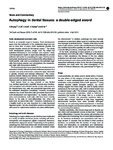Autophagy in dental tissues: a double-edged sword
| dc.contributor.author | Zhuang, H | |
| dc.contributor.author | Ali, Kamran | |
| dc.contributor.author | Ardu, S | |
| dc.contributor.author | Tredwin, Christopher | |
| dc.contributor.author | Hu, Bing | |
| dc.date.accessioned | 2016-04-15T07:45:35Z | |
| dc.date.available | 2016-04-15T07:45:35Z | |
| dc.date.issued | 2016-04-14 | |
| dc.identifier.issn | 2041-4889 | |
| dc.identifier.issn | 2041-4889 | |
| dc.identifier.other | ARTN e2192 | |
| dc.identifier.uri | http://hdl.handle.net/10026.1/4504 | |
| dc.description.abstract |
Tooth development and stem cells Tooth is an essential organ in humans. Tooth development spans from the embryonic to the adolescent stage and can last for more than 10 years, which represents possibly the longest duration among all the human organs.1 The whole tooth development process ranges from the initial oral epithelium thickening to root formation and eruption.1 Early tooth development results in rapid cell proliferation to provide sufficient cell number for populating the organ. The key events during later developments are involved in the differentiation of 'tooth-specific' cells such as ameloblasts, the epithelial origin cells that produce enamel, and odontoblasts, the mesenchymal origin cells that produce dentine. The long time duration associated with the development and maturation of teeth, followed by their continuous exposure to a complex oral cavity environment, makes the teeth vulnerable to genetic, intrinsic and extrinsic influences. The consequences include failures and defects of tooth development, such as tooth agenesis, as well as being prone to trauma and diseases such as dental caries and periodontitis. Tooth tissues have no (e.g. enamel) or very limited (e.g. dentine) regeneration capability because upon development completion only a limited number of stem cells persist in the mesenchyme (e.g. pulp and periodontal ligaments) and the epithelium disappears completely. However, increasing evidence has shown that stem cells are indeed important for tooth development and regeneration, as, besides chondrocytes and osteoblasts, tooth pulp cells have been recently shown to be able to trans-differentiate into other cell types such as neuron-like cells. Therefore, maintenance of a healthy tooth is not only important for a fully functional digestive system, but also essential to preserve an important cell source for regenerative medicine and stem cell therapies. | |
| dc.format.extent | e2192-e2192 | |
| dc.format.medium | Electronic | |
| dc.language | en | |
| dc.language.iso | en | |
| dc.publisher | Springer Science and Business Media LLC | |
| dc.subject | Aging | |
| dc.subject | Anesthetics | |
| dc.subject | Autophagy | |
| dc.subject | Bacterial Physiological Phenomena | |
| dc.subject | Cell Differentiation | |
| dc.subject | Fluorides | |
| dc.subject | Humans | |
| dc.subject | Odontoblasts | |
| dc.subject | Periodontitis | |
| dc.subject | Tooth | |
| dc.title | Autophagy in dental tissues: a double-edged sword | |
| dc.type | journal-article | |
| dc.type | News | |
| dc.type | Research Support, Non-U.S. Gov't | |
| plymouth.author-url | https://www.webofscience.com/api/gateway?GWVersion=2&SrcApp=PARTNER_APP&SrcAuth=LinksAMR&KeyUT=WOS:000375277600019&DestLinkType=FullRecord&DestApp=ALL_WOS&UsrCustomerID=11bb513d99f797142bcfeffcc58ea008 | |
| plymouth.issue | 4 | |
| plymouth.volume | 7 | |
| plymouth.publication-status | Published online | |
| plymouth.journal | Cell death and disease | |
| dc.identifier.doi | 10.1038/cddis.2016.103 | |
| plymouth.organisational-group | /Plymouth | |
| plymouth.organisational-group | /Plymouth/Faculty of Health | |
| plymouth.organisational-group | /Plymouth/Faculty of Health/Peninsula Dental School | |
| plymouth.organisational-group | /Plymouth/REF 2021 Researchers by UoA | |
| plymouth.organisational-group | /Plymouth/REF 2021 Researchers by UoA/UoA03 Allied Health Professions, Dentistry, Nursing and Pharmacy | |
| plymouth.organisational-group | /Plymouth/Research Groups | |
| plymouth.organisational-group | /Plymouth/Research Groups/Institute of Translational and Stratified Medicine (ITSMED) | |
| plymouth.organisational-group | /Plymouth/Research Groups/Institute of Translational and Stratified Medicine (ITSMED)/CBR | |
| plymouth.organisational-group | /Plymouth/Users by role | |
| plymouth.organisational-group | /Plymouth/Users by role/Academics | |
| plymouth.organisational-group | /Plymouth/Users by role/Researchers in ResearchFish submission | |
| dc.publisher.place | England | |
| dcterms.dateAccepted | 2016-03-31 | |
| dc.identifier.eissn | 2041-4889 | |
| dc.rights.embargoperiod | Not known | |
| rioxxterms.versionofrecord | 10.1038/cddis.2016.103 | |
| rioxxterms.licenseref.uri | http://www.rioxx.net/licenses/all-rights-reserved | |
| rioxxterms.licenseref.startdate | 2016-04-14 | |
| rioxxterms.type | Journal Article/Review | |
| plymouth.funder | Role of the FoxN1 gene as a central regulator of epidermal planar cell polarity signaling expression and function::BBSRC |


